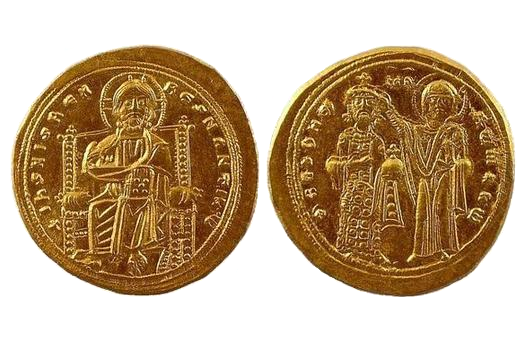
about ancient nomos
Ancient Nomos Art is a museum of galleries exhibiting ancient coins and ancient mint maps. The coin gallery displays the diverse art and history of hand-crafted ancient Greek, Roman, Byzantine, Persian and Medieval coinage. The ancient mints mapping gallery features Greek, Roman, Byzantine, Asia Minor and Medieval mint city regions and territories. Visitor's are welcome to explore, study and enjoy Ancient Nomos Art.

Byzantine, Roman – 1028 AD
Romanus III
From Ancient Galleries

Obverse: Christ nimbate and seated facing on straight-backed throne, raising right hand in benediction and holding the Gospels in left hand; beaded border.
Reverse: Virgin Mary nimbate standing facing right and crowning Romanus who holds globus cruciger, garbed in saccos and jeweled loros with five pellets in hem.
LEGEND
Obv: +IhSXISRЄX RЄςNANTIηm Nimbate Christ enthroned facing, wearing nimbus cruciger, pallium and colobium, raising right hand in benediction and holding the book of Gospels in left hand. Rev: ΘCЄbOHΘ’ RωmAηω; The Virgin Mary nimbate standing to right; bearded Romanus on left, both stand facing. The virgin wears pallium and maphorium, and with her right hand crowns the emperor, who wears saccos and jeweled loros and holds globus cruciger in right hand; in between their heads, MΘ under single bar. Five pellets on hem fold of robe beneath globus cruciger. Double border of dots.
Romanus III Argyros, at the age of sixty, was forced by Constantine VIII to divorce his first wife and marry the Emperor’s fifty year old sister Zoë in 1028 AD. Three days after the wedding, Constantine VIII died and Romanus was proclaimed Emperor. Romanus was a pious nobleman and enjoyed lavishing vast funds on the enrichment of churches and endowing the Christian monks. While military success was his goal, he failed in his first endeavor attempting to forestall advancing Muslims by the emir of Aleppo at Azaz. His state administration also lacked the wisdom required to properly impose taxation, curtail privileges of the nobility, and prevent free peasants and soldiers from falling into conditions of serfdom. The gold coinage of Romanus III continues the Byzantine tradition of depicting Christian icons. The obverse coin above depicts Christ seated holding the Gospels, wearing a nimbus cruciger, pallium and colobium, with hand raised in benediction. The reverse depicts the Virgin Mary nimbate, crowning Romanus III who stands facing, wearing his loros and holding the globus cruciger. Romanus III is said to have a particular devotion to the Virgin Mary associated with the great monastery of St. Mary Peribleptos (P Grierson). Here is where Romanus discovered the Theotokos Nikopoios, an image of Mary painted on wood with gold and silver, during his renovations of the church of the Blachernae. As a whole, The Romanus III coinage reflects the predominant middle Byzantine tradition devoted to Christian imagery and symbolism.
DOCUMENTATION
Value: Histamenon. Metal: Gold. Weight: 4.41 grams. Mint: Constantinople. Date: 1028-1034 AD.
Attribution: Dumbarton Oaks Collection, 1d; Sear, Byzantine Coins 1819; Berk-296.
Legend, Documentation and Attribution
